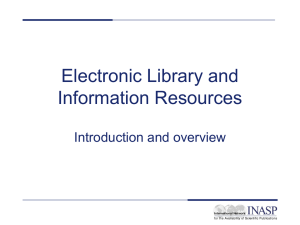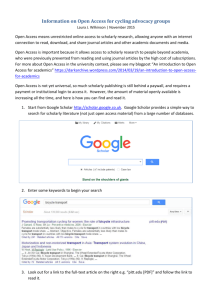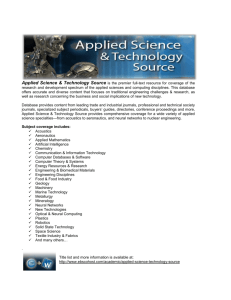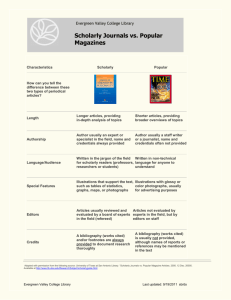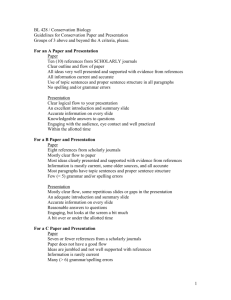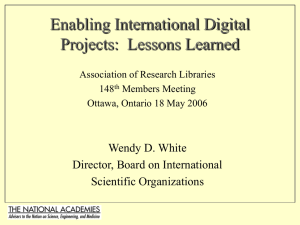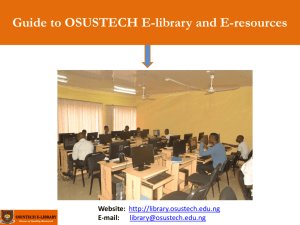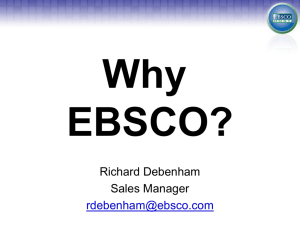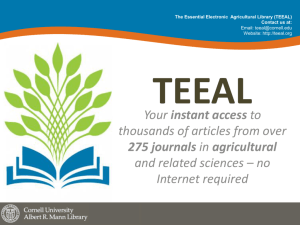meta data
advertisement
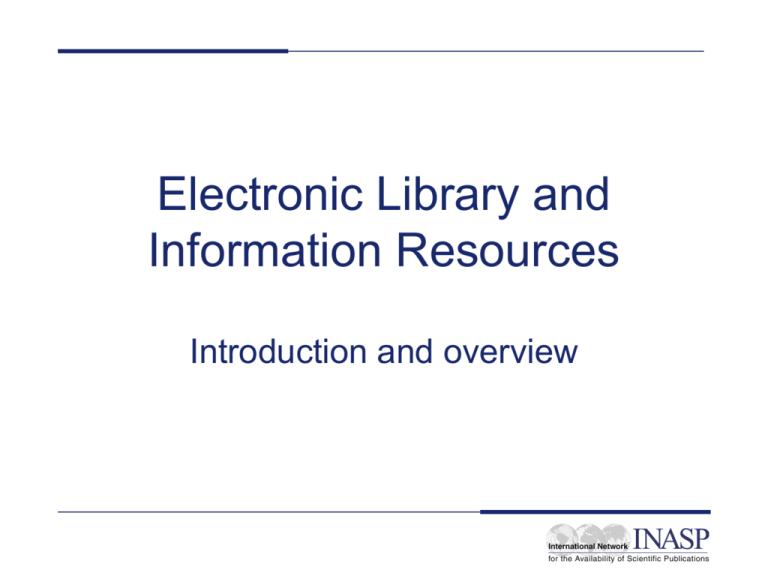
Electronic Library and Information Resources Introduction and overview Objectives Participants will be able to: • Describe the different types of e-resource • Contrast their features and functionality • Describe the different access routes for electronic resources • Identify some of the access options available within developing countries • Access scholarly electronic resources What is an ‘electronic library resource’? Any library or information resource that can be accessed via computer, e.g. 1. Electronic journals 2. Scholarly databases 3. Information gateways 4. The Internet Also e-books, reports, magazines, grey literature 1. Electronic journals • Full-text - whole journal available – Electronic version of print – Electronic only – Examples at www3.oup.co.uk/jnls/ • Partial full-text - selected articles only • Table of contents or abstracts only – Examples at www.ajol.info Why use e-journals? • Up-to-date • Convenient: information at your desktop • Value-added features: search facilities, links to other databases, supplementary information, graphics, etc • Access to a wider range of material than might be available through your local library 2. Scholarly databases • • • • • • Bibliographic: references to published material Numeric: e.g. statistical tables Full text: complete publications Audio: collections of music Image: e.g. collections of slides Multimedia: audio-visual, animation etc • Examples:EBSCO Host – licensed, range of electronic information resources, huge volume of information Why use scholarly databases? • Provide information for a specific project or topic • Provide an overview of research activity in a given area • Up-to-date information on a specific subject area through regular scanning • Allow searching over large bodies of data and academic type information 3. Information Gateways • Subject Based Information Gateways (SBIGs): – web sites that act as a gateway to other sites and information resources. • Rely on human creation of meta data • Subject experts select, evaluate, describe, classify • Smaller, subject-focused databases • Lower recall, higher precision • E.g. PINAKES (information gateway gateway!) Why use information gateways? • High quality information – selected by human subject experts • Classification and description of resources • Subject-specific focus • Good starting places that lead to other quality resources 4. The Internet • Huge information resource – 3-10 billion pages of information • Continually growing and changing • No national, political, scientific barriers • Efficient search tools allow relatively easy navigation, e.g. – www.google.com – www.alltheweb.com Electronic resources: strengths • Huge range of information available – >8 billion web pages – >20,000 journals • • • • Timely, up-to-date information sources ‘Value added’ functionality (e.g. searching) Additional skills development – ICT skills Large volume of quality, free information Electronic resources: weaknesses • Technical barriers to use – need computers, network connection, software, etc • Infrastructural problems – bandwidth and telecommunications issues – unreliable electricity supplies, etc • Skills and training requirements • Costs can be high: technology and content • Variable quality of information How can we access resources? • Most academic e-resources are feebased – often very high costs (although variable) – subscriptions to individual/group/organisation/ nation/region – pay-per-view models • Growing movement of “open access” • Authentication via username/password or IP address Preferential licensing agreements • Publishers and development organisations working together to enable access to information to aid development – restricted to specific organisations in low income countries • Range of initiatives, focusing on different users, subjects, geographical areas, etc. – HINARI, PERI, TEEAL, eIFL, AGORA, etc. • Free at point of use HINARI • • • • • • Health InterNetwork Access to Research Initiative Led by the World Health Organisation Over 2000 STM journals from major publishers 100+ eligible countries Institutional level licensing Free or heavily discounted access • www.healthinternetwork.org/ PERI • Programme for the Enhancement of Research Information • Led by INASP • Over 17,000 full-text journals in all disciplines from major publishers (countries select resources) • 100+ eligible countries • National level licenses • Subsidised and/or heavily discounted • www.inasp.info/peri/ TEEAL • The Essential Electronic Agricultural Library • Led by Cornell University • Over 140 journals in the field of agrosciences • CD-Roms • 100+ eligible countries • Institutional level licenses • Heavily discounted access • http://teeal.cornell.edu/ eIFL • Electronic Information for Libraries • Led by Open Society Institute/Soros foundations network • Negotiates affordable subscriptions on a multi-country consortial basis • 43 participating countries • national level licenses • www.eifl.net/ AGORA • Access to Global Online Research in Agriculture • Led by UN Food and Agriculture Organisation • Over 700 journals in food, agriculture, environmental sci, related social sciences • Around 70 eligible countries • Institutional level licenses • Free or heavily discounted access • http://www.aginternetwork.org/en/ Open access initiatives • Significant movement in academic community that information should be “free” to all • Access problems and costs are universal • Author pays versus user pays • Open archiving, pre-prints, open access, self archiving, institutional archives or subject specific archives • Tends to be techno-centric at present Open access examples • PubMed Central – hard sciences – www.pubmedcentral.nih.gov/ • BioMed Central – medicine – www.biomedcentral.com/ • DOAJ – all subjects – www.doaj.org/ • Bioline – research from developing countries – http://www.bioline.org.br/ Summary • Range of electronic resources is huge + growing • The type, quality and usefulness varies enormously • The strengths/weaknesses and support needs must be considered for sustainable use • Free and fee resources • Many useful programmes and partners that can help with access to resources – (see list in handouts + INASP directory) • Interesting developments in “Open access” Thank you Any questions?
